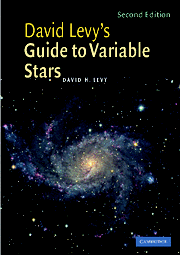Book contents
- Frontmatter
- Contents
- Foreword to the first edition
- Preface
- Acknowledgments
- Part I Getting to know the sky
- Part II Getting to know the variables
- Part III Suggested variables for observation throughout the year
- Part IV A miscellany
- 32 Stars and people
- 33 “Hands-on Astrophysics” and the next generation
- 34 Going further
- 35 Glossary and abbreviations
- Index
32 - Stars and people
from Part IV - A miscellany
Published online by Cambridge University Press: 05 August 2012
- Frontmatter
- Contents
- Foreword to the first edition
- Preface
- Acknowledgments
- Part I Getting to know the sky
- Part II Getting to know the variables
- Part III Suggested variables for observation throughout the year
- Part IV A miscellany
- 32 Stars and people
- 33 “Hands-on Astrophysics” and the next generation
- 34 Going further
- 35 Glossary and abbreviations
- Index
Summary
Variable-star observing was something people had to appreciate and discover. As an observing discipline, it was forced on us time and again as bright exploding suns intruded in our otherwise placid sky. Opening and closing suddenly with each major nova, observers could watch these intruders with fear and with questions, but these stars did not appear to have any lasting effect on early civilization. Novae and comets shared the uncertain interpretation of being signs of something else, rather than being objects of intrinsic interest.
Ancient Chinese and native American records of supernovae are the earliest surviving variable-star reports. The “guest star” of 1054, for example, appeared at a time when these people would be looking beyond, to new things, and would keep careful records of anything extraordinary.
The history of variable-star observing closely parallels the sudden launching of Renaissance astronomical curiosity. The quiet, orderly sky of Ptolemy offered comfort with safe spheres, all fixed in content, of which the stellar was the most distant or purest.
In 1572, a bright new light punched a hole through that sphere, shattering the concept of order without change. Observations by Tycho recorded not only the appearance of this incredible sun but also its changing brightness over time. The sphere had changed, but the thing that changed it was changing in itself! If the conservative scientific establishment wanted to believe that the supernova in Cassiopeia was an aberration not to be concerned with, a second new star in 1604 added to the growing evidence that the sky was a dynamic picture.
- Type
- Chapter
- Information
- David Levy's Guide to Variable Stars , pp. 237 - 243Publisher: Cambridge University PressPrint publication year: 2005

